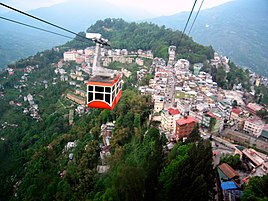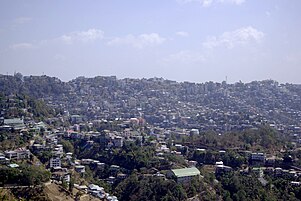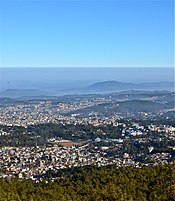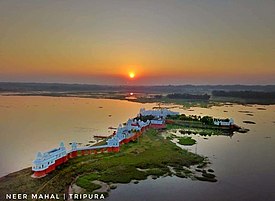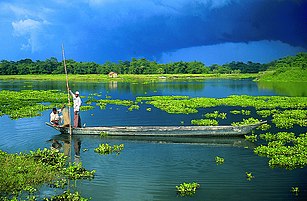|
Northeast India
Northeast India, officially the North Eastern Region (NER), is the easternmost region of India representing both a geographic and political administrative division of the country.[18] It comprises eight states—Arunachal Pradesh, Assam, Manipur, Meghalaya, Mizoram, Nagaland and Tripura (commonly known as the "Seven Sisters"), and the "brother" state of Sikkim.[19] The region shares an international border of 5,182 kilometres (3,220 mi) (about 99 per cent of its total geographical boundary) with several neighbouring countries – 1,395 kilometres (867 mi) with China in the north, 1,640 kilometres (1,020 mi) with Myanmar in the east, 1,596 kilometres (992 mi) with Bangladesh in the south-west, 97 kilometres (60 mi) with Nepal in the west, and 455 kilometres (283 mi) with Bhutan in the north-west.[20] It comprises an area of 262,184 square kilometres (101,230 sq mi), almost 8 per cent of that of India. The Siliguri Corridor connects the region to the rest of mainland India. The states of North Eastern Region are officially recognised under the North Eastern Council (NEC),[19] constituted in 1971 as the acting agency for the development of the north eastern states. Long after induction of NEC, Sikkim formed part of the North Eastern Region as the eighth state in 2002.[21][22] India's Look-East connectivity projects connect Northeast India to East Asia and ASEAN. The city of Guwahati in Assam is referred to as the "Gateway to the Northeast" and is the largest metropolis in Northeast India. History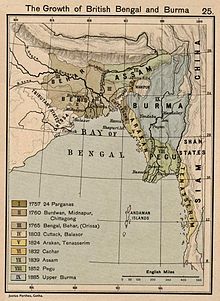 Assam annexation to British India in 1838 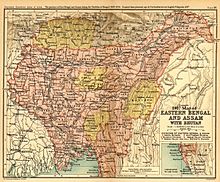 Eastern Bengal and Assam in 1907 The earliest settlers may have been Austroasiatic speakers from Southeast Asia, followed by Tibeto-Burman speakers from China, and by 500 BCE Indo-Aryan speakers from the Gangetic Plains as well as Kra–Dai speakers from southern Yunnan and Shan State.[23] Due to the biodiversity and crop diversity of the region, archaeological researchers believe that early settlers of Northeast India had domesticated several important plants.[24] Historians believe that the 100 BCE writings of Chinese explorer Zhang Qian indicate an early trade route via Northeast India.[25] The Periplus of the Erythraean Sea mentions a people called Sêsatai in the region,[26] who produced malabathron (cinnamon-like aromatic leaves, dried and used as a flavouring agent), so prized in the old world.[27] Ptolemy's Geographia (2nd century CE) calls the region Kirrhadia, apparently after the Kirata population.[28] In the early historical period (most of the first millennium CE), Kamarupa straddled most of present-day Northeast India. Xuanzang, a travelling Chinese Buddhist monk, visited Kamarupa in the 7th century CE. He described the people as "short in stature and black-looking", whose speech differed a little from mid-India and who were of simple but violent disposition. He wrote that the people in Kamarupa knew of Sichuan, which lay to the kingdom's east beyond a treacherous mountain.[29] The northeastern states were established during the British Raj of the 19th and early 20th centuries, when they became relatively isolated from traditional trading partners such as Bhutan and Myanmar.[30] Many of the peoples in present-day Mizoram, Meghalaya and Nagaland converted to Christianity under the influence of British (Welsh) missionaries.[31] Formation of North Eastern statesSince the Moamoria disturbances, the Ahom dynasty was on the decline. The British appeared on the scene in the guise of saviours.[32] In the early 19th century, both the Ahom and the Manipur kingdoms fell to a Burmese invasion.[32] The ensuing First Anglo-Burmese War resulted in the entire region coming under British control. In the colonial period (1826–1947), North East India was made a part of Bengal Province from 1839 to 1873, after which Colonial Assam became its own province,[33] but which included Sylhet. After Indian Independence from British Rule in 1947, the Northeastern region of British India consisted of Assam and the princely states of Tripura Kingdom and Manipur Kingdom. Subsequently, Manipur and Tripura were made Union Territories of India in 1956 and in 1972 attained fully-fledged statehood. Later, Nagaland attained statehood in 1963, Meghalaya in 1972. Arunachal Pradesh and Mizoram became full-fledged states on 20 February 1987, being carved out of the large territory of Assam.[34] Sikkim was integrated as the eighth North Eastern Council state in 2002.[21] The city of Shillong served as the capital of the Assam province created during British Rule. It remained the capital of undivided Assam until the formation of the state of Meghalaya in 1972.[35] The capital of Assam was shifted to Dispur, a part of Guwahati, and Shillong was designated as the capital of Meghalaya.[citation needed]
World War IIInitially, the Japanese had invaded British territories in Southeast Asia, including Burma (now Myanmar), with the intention of creating a fortified perimeter around Japan. The British had neglected the defence of Burma, and by early 1942, the Japanese had captured Rangoon and pushed Allied forces back towards India through a gruelling retreat.[40] In response to the Japanese advance, the British formed the South East Asia Command (SEAC) under Admiral Lord Louis Mountbatten in November 1943. This command brought new energy to the war effort in the region and emphasised the importance of standing firm and fighting on despite logistical challenges, such as during the monsoon season.[41] The Japanese launched an offensive in March 1944 aimed at capturing Imphal and Kohima, key locations in northeast India. Capturing these areas would have allowed the Japanese to disrupt Allied supply lines to China and launch air attacks against India.[42] However, the Allied forces, under the leadership of Field Marshal William Slim, held firm. They adopted aggressive tactics, including the creation of defensive "boxes" and the use of jungle warfare techniques. Despite being surrounded, the defenders at Kohima held out against intense Japanese attacks until reinforcements arrived.[43] The battles of Imphal and Kohima resulted in a decisive defeat for the Japanese. They suffered heavy casualties and were forced to retreat, marking a turning point in the Burma Campaign. The Allied victory paved the way for subsequent offensives to clear Japanese forces from Burma and ultimately led to the re-conquest of the region.[44] Sino-Indian War (1962) Arunachal Pradesh, a state in the Northeastern tip of India, is claimed by China as South Tibet.[45] Sino-Indian relations degraded, resulting in the Sino-Indian War of 1962. The cause of the escalation into war is still disputed by both Chinese and Indian sources. During the war in 1962, the PRC (China) captured much of the NEFA (North-East Frontier Agency) created by India in 1954. But on 21 November 1962, China declared a unilateral ceasefire, and withdrew its troops 20 kilometres (12 mi) behind the McMahon Line. China returned Indian prisoners of war in 1963.[46] Seven Sister StatesThe Seven Sister States is a popular term for the contiguous states of Arunachal Pradesh, Assam, Meghalaya, Manipur, Mizoram, Nagaland and Tripura prior to inclusion of the state of Sikkim into the North Eastern Region of India. The sobriquet 'Land of the Seven Sisters' was coined to coincide with the inauguration of the new states in January 1972 by Jyoti Prasad Saikia,[47] a journalist in Tripura, in the course of a radio talk show. He later compiled a book on the interdependence and commonness of the Seven Sister States. It has been primarily because of this publication that the nickname has caught on.[48] Geography The Northeast region can be physiographically categorised into the Eastern Himalaya, the Patkai and the Brahmaputra and the Barak valley plains. Northeast India (at the confluence of Indo-Malayan, Indo-Chinese, and Indian biogeographical realms) has a predominantly humid sub-tropical climate with hot, humid summers, severe monsoons, and mild winters. Along with the west coast of India, this region has some of the Indian subcontinent's last remaining rainforests, which support diverse flora and fauna and several crop species. Reserves of petroleum and natural gas in the region are estimated to constitute a fifth of India's total potential.[citation needed] The region is covered by the mighty Brahmaputra-Barak river systems and their tributaries. Geographically, apart from the Brahmaputra, Barak and Imphal valleys and some flatlands in between the hills of Meghalaya and Tripura, the remaining two-thirds of the area is hilly terrain interspersed with valleys and plains; the altitude varies from almost sea-level to over 7,000 metres (23,000 ft) above MSL. The region's high rainfall, averaging around 10,000 millimetres (390 in) and above creates problems of the ecosystem, high seismic activity, and floods. The states of Arunachal Pradesh and Sikkim have a montane climate with cold, snowy winters and mild summers.[citation needed]
TopographyHighest peaks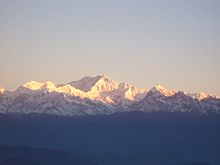 Mt. Kanchenjunga, Sikkim Kangchenjunga, the third highest mountain peak in the world rising to an altitude of 8,586 m (28,169 ft), lies in-between the state Sikkim and adjacent country Nepal. Brahmaputra river basin Brahmaputra river basin 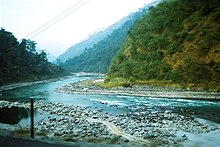 Teesta River, Sikkim Tributaries of the Brahmaputra River in Northeast India: Climate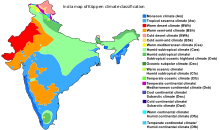 Indian map of Köppen climate classification Northeast India has a subtropical climate that is influenced by its relief and influences from the southwest and northeast monsoons.[49][50] The Himalayas to the north, the Meghalaya plateau to the south and the hills of Nagaland, Mizoram and Manipur to the east influences the climate.[51] Since monsoon winds originating from the Bay of Bengal move northeast, these mountains force the moist winds upwards, causing them to cool adiabatically and condense into clouds, releasing heavy precipitation on these slopes.[51] It is the rainiest region in the country, with many places receiving an average annual precipitation of 2,000 mm (79 in), which is mostly concentrated in summer during the monsoon season.[51] Cherrapunji, located on the Meghalaya plateau is one of the rainiest place in the world with an annual precipitation of 11,777 mm (463.7 in).[51] Temperatures are moderate in the Brahmaputra and Barak valley river plains which decreases with altitude in the hilly areas.[51] At the highest altitudes, there is permanent snow cover.[51] In general, the region has 3 seasons: Winter, Summer, and rainy season in which the rainy season coincides with the summer months much like the rest of India.[52] Winter is from early November until mid March while summer is from mid-April to mid-October.[51] Under the Köppen climate classification, the region is divided into 3 broad types: A (tropical climates), C (warm temperate mesothermal climates), and D (snow microthermal climates).[53][54] The tropical climates are located in parts of Manipur, Tripura, Mizoram, and the Cachar plains south of 25oN and are classified as tropical wet and dry (Aw).[53] Much of Assam, Nagaland, northern parts of Meghalaya and Manipur and parts of Arunachal Pradesh fall within the warm temperature mesothermal climates (type C) where the mean temperatures in coldest months range from −3 to 18 °C (27 to 64 °F).[54][55] The entire Brahmaputra valley has a humid subtropical climate (Cfa/Cwa) with hot summers.[54][55] At altitudes between 500 and 1,500 m (1,600 and 4,900 ft) located in the eastern hills of Nagaland, Manipur and Arunachal Pradesh, a (Cfb/CWb) climate prevails with warm summers.[54][55] Locations above 1,500 m (4,900 ft) in Meghalaya, parts of Nagaland, and northern Arunachal Pradesh have a (Cfc/Cwc) climate with short and cool summers.[55] Finally, the extreme northern parts of Arunachal Pradesh are classified as humid continental climates with mean winter temperatures below −3 °C (27 °F).[54][56]
Temperatures vary by altitude with the warmest places being in the Brahmaputra and Barak River plains and the coldest at the highest altitudes.[57] It is also influenced by proximity to the sea with the valleys and western areas being close to the sea, which moderates temperatures.[57] Generally, temperatures in the hilly and mountainous areas are lower than the plains which lie at a lower altitude.[58] Summer temperatures tend to be more uniform than winter temperatures due to high cloud cover and humidity.[59] In the Brahmaputra and Barak valley river plains, mean winter temperatures vary between 16 and 17 °C (61 and 63 °F) while mean summer temperatures are around 28 °C (82 °F).[57] The highest summer temperatures occur in the West Tripura plain with Agartala, the capital of Tripura having mean maximum summer temperatures ranging between 33 and 35 °C (91 and 95 °F) in April.[60] The highest temperatures in summer occur before the arrival of monsoons and thus eastern areas have the highest temperatures in June and July where the monsoon arrives later than western areas.[60] In the Cachar Plain, located south of the Brahmaputra plain, temperatures are higher than the Brahmaputra plain although the temperature range is smaller owing to higher cloud cover and the monsoons that moderate night temperatures year round.[58][60] In the mountainous areas of Arunachal Pradesh, the Himalayan ranges in the northern border with India and China experience the lowest temperatures with heavy snow during winter and temperatures that drop below freezing.[58] Areas with altitudes exceeding 2,000 metres (6,562 ft) receive snowfall during winters and have cool summers.[58] Below 2,000 metres (6,562 ft) above sea level, winter temperatures reach up to 15 °C (59 °F) during the day with nights dropping to zero while summers are cool, with a mean maximum of 25 °C (77 °F) and a mean minimum of 15 °C (59 °F).[58] In the hilly areas of Meghalaya, Nagaland, Manipur and Mizoram, winters are cold while summers are cool.[59] The plains in Manipur has colder winter minimums than what is warranted by its elevation owing to being surrounded by hills on all sides.[61] This is due to temperature inversions during winter nights when cold air descends from the hills into the valleys below and its geographic location which prevents winds that bring hot temperatures and humidity from coming into the Manipur plain.[61] For example, in Imphal, winter daytime temperatures hover around 21 °C (70 °F) but nighttime temperatures drop to 3 °C (37 °F).[61]
No part of Northeast India receives less than 1,000 mm (39 in) of rainfall a year.[52] Areas in the Brahmputra valley receive 2,000 mm (79 in) of rainfall a year while mountainous areas receive 2,000 to 3,000 mm (79 to 118 in) a year.[52] The southwest monsoon is responsible for bringing 90% of the annual rainfall to the region.[62] April to late October are the months where most of the rainfall in Northeast India occurs with June and July being the rainiest months.[62] In most parts of the region, the average date of onset of the monsoons is 1 June.[63] Southern areas are the first to receive the monsoon (May or June) with the Brahmaputra valley and the mountainous north receiving later (later May or June).[62] In the hilly parts of Mizoram, the closer proximity to the Bay of Bengal causes it to experience early monsoons with June being the wettest season.[62] High-risk seismic zone India Plate and other tectonic plates The North Eastern Region of India is a mega-earthquake prone zone caused by active fault planes beneath formed by the convergence of three tectonic plates viz. India Plate, Eurasian Plate and Burma Plate. Historically the region has suffered from two great earthquakes (M > 8.0) – 1897 Assam earthquake and 1950 Assam-Tibet earthquake – and about 20 large earthquakes (8.0 > M > 7.0) since 1897.[64][65] The 1950 Assam-Tibet earthquake is still the largest earthquake in India.[citation needed] WildlifeFlora WWF has identified the entire Eastern Himalayas as a priority Global 200 ecoregion. Conservation International has upscaled the Eastern Himalaya hotspot to include all the eight states of Northeast India, along with the neighbouring countries of Bhutan, southern China and Myanmar. The region has been identified by the Indian Council of Agricultural Research as a center of rice germplasm. The National Bureau of Plant Genetic Resources (NBPGR), India, has highlighted the region as being rich in wild relatives of crop plants. It is the center of origin of citrus fruits. Two primitive variety of maize, Sikkim Primitive 1 and 2, have been reported from Sikkim (Dhawan, 1964). Although jhum cultivation, a traditional system of agriculture, is often cited as a reason for the loss of forest cover of the region, this primary agricultural economic activity practised by local tribes supported the cultivation of 35 varieties of crops. The region is rich in medicinal plants and many other rare and endangered taxa. Its high endemism in both higher plants, vertebrates, and avian diversity has qualified it as a biodiversity hotspot. The following figures highlight the biodiversity significance of the region:[66]
Fauna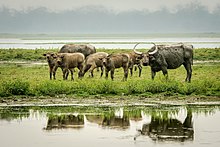 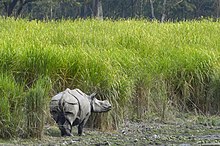 The International Council for Bird Preservation, UK identified the Assam plains and the Eastern Himalaya as an Endemic Bird Area (EBA). The EBA has an area of 220,000 km2 following the Himalayan range in the countries of Bangladesh, Bhutan, China, Nepal, Myanmar and the Indian states of Sikkim, North Bengal, Assam, Nagaland, Manipur, Meghalaya and Mizoram. Because of a southward occurrence of this mountain range in comparison to other Himalayan ranges, this region has a distinctly different climate, with warmer mean temperatures and fewer days with frost, and much higher rainfall. This has resulted in the occurrence of a rich array of restricted-range bird species. More than two critically endangered species, three endangered species, and 14 vulnerable species of birds are in this EBA. Stattersfield et al. (1998) identified 22 restricted range species, out of which 19 are confined to this region and the remaining three are present in other endemic and secondary areas. Eleven of the 22 restricted-range species found in this region are considered as threatened (Birdlife International 2001), a number greater than in any other EBA of India.[citation needed] Northeast India is very rich in faunal diversity. There are as many as 15 species of non-human primates and most important of them are hoolock gibbon, stumptied macaque, pigtailed macaque, golden langur, hanuman langur and rhesus monkey. The most important and endangered species is one-horned rhinoceros. The forests of the region are also the habitats of elephant, royal Bengal tiger, leopard, golden cat, fishing cat, marbled cat, Bengal fox etc. the Gangetic dolphin in the Brahmaputra is also an endangered species. The other endangered species are otter, mugger crocodile, tortoise and some fishes.[67] WWF has identified the following priority ecoregions in North-East India:
National parksState symbols
Demographics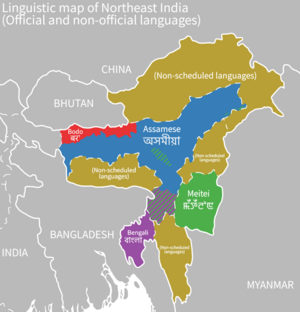 The total population of Northeast India is 46 million with 68 per cent of that living in Assam alone. Assam also has a higher population density of 397 persons per km2 than the national average of 382 persons per km2. The literacy rates in the states of the Northeastern region, except those in Arunachal Pradesh and Assam, are higher than the national average of 74 per cent. As per 2011 census, Meghalaya recorded the highest population growth of 27.8 per cent among all the states of the region, higher than the national average at 17.64 per cent; while Nagaland recorded the lowest in the entire country with a negative 0.5 per cent.[73]
Largest cities by populationAccording to 2011 Census of India, the largest cities in Northeast India are
Languages Northeast India constitutes a single linguistic region within the Indian national context, with about 220 languages in multiple language families (Indo-European, Sino-Tibetan, Kra–Dai, Austroasiatic, as well as some creole languages) that share a number of features that set them apart from most other areas of the Indian subcontinent (such as alveolar consonants rather than the more typical dental/retroflex distinction).[75][76] Assamese, an Indo-Aryan language spoken mostly in the Brahmaputra Valley, developed as a lingua franca for many speech communities. Assamese-based pidgin/creoles have developed in Nagaland (Nagamese) and Arunachal (Nefamese),[77] though Nefamese has been replaced by Hindi in recent times. Bengali language is another Indo-Aryan language spoken in South Assam in the Barak Valley and Tripura, being the majority and official language in both the regions. The Austro-Asiatic family is represented by the Khasi, Jaintia and War languages of Meghalaya. A small number of Tai–Kadai languages (Ahom, Tai Phake, Khamti, etc.) are also spoken. Sino-Tibetan is represented by a number of languages that differ significantly from each other,[78] some of which are: Boro, Rabha, Karbi, Mising, Tiwa, Deori, Hmar (including Biate, Chorei, Halam, Hrangkhawl, Kaipeng, Molsom, Ranglong, Saihriem, Sakachep, Thangachep, Thiek), Zeme Naga, Rengma Naga and, Kuki (Thadou language) (Assam); Garo, Rabha, Hmar (including Biate, Sakachep) (Meghalaya); Ao, Angami, Sema, Lotha, Konyak, Chakhesang, Chang, Khiamniungan, Phom, Pochury, Rengma, Sangtam, Tikhir, Yimkhiung, Zeliang, Kuki (Thadou), and Hmar (including Sakachep/Khelma) etc. (Nagaland); Mizo languages such as Lusei (including Hualngo), Hmar (including Chorei, Darlawng, Darngawn, Kaipeng, Khawlhring, Molsom, Ngente, Sakachep, Zote), Lai (including Hakha, Falam, Khualsim, Zanniet, Sim), Mara languages, Ralte/Galte, Zomi/Paihte, Kuki/Thahdo, etc. (Mizoram); Hrusso, Tanee, Niyshi, Adi, Abor, Nocte, Apatani, Mishmi etc. (Arunachal). Kokborok is the dominant among the tribal people of Tripura and one of the official languages of the state, while Garo, Hmar (including Bong, Bongcher, Chorei, Dab, Darlawng, Hmarchaphang, Hrangkhawl, Langkai, Kaipeng, Koloi, Korbong, Molsom, Ranglong, Rupini, Saihmar, Sakachep, Thangachep)), Lusei (including Rokhum), etc are also spoken. Meitei is the official language in Manipur, the dominant language of the Imphal Valley; while "Naga" languages such as Poumai, Mao, Maram, Rongmei (Kabui),Tangkhul, Zeme, Liangmei, Inpui, Thangal Naga and Mizo languages such as Kuki/Thado, Lusei, Zomi languages (including Paite, Simte, Vaiphei, Zou, Mate, Thangkhal, Tedim-Chin), Gangte and Hmar languages (including Biete, Hrangkhawl, Thiek, Zote) predominate in individual hill areas of the state.[79] Among other Indo-Aryan languages, Chakma is spoken in Mizoram and Hajong in Assam and Meghalaya. Nepali, an Indo-Aryan language, is dominant in Sikkim, besides the Sino-Tibetan languages Limbu, Bhutia, Lepcha, Rai, Tamang, Sherpa, etc. Bengali was made the official language of Colonial Assam from 1836 to 1873.[82] Official languages
Etymology of state names
ReligionsReligion in Northeast India (2011) Hinduism (54.02%) Islam (25.05%) Christianity (17.24%) Buddhism (1.37%) Jainism (0.07%) Sikhism (0.07%) Other (1.97%) No religion (0.21%)
Hinduism is the majority religion in the North Eastern states of Assam, Tripura, Manipur, Sikkim and plurality in Arunachal Pradesh, while Christianity is the majority religion in Meghalaya, Nagaland, Mizoram and plurality in Manipur and Arunachal Pradesh. A significant plurality of the state of Arunachal Pradesh follows the indigenous religion Donyi-Polo. Islam has a significant presence in Assam and about 93% of all North East Muslim population is concentrated in that state alone. A bulk of Christian population in India resides in North East, as about 30% of India's Christian population is concentrated in North Eastern region alone. There is a significant presence of Buddhism in Sikkim, Arunachal Pradesh and Mizoram.[88]
Ethnic groupsNortheast India has over 220 ethnic groups and an equal number of dialects in which Bodo form the largest indigenous ethnic group.[90] The hills states in the region like Arunachal Pradesh, Meghalaya, Mizoram, and Nagaland are predominantly inhabited by tribal people with a degree of diversity even within the tribal groups. The region's population results from ancient and continuous flows of migrations from Tibet, Indo-Gangetic India, the Himalayas, present Bangladesh, and Myanmar.[91] Majority communitiesThese ethnic groups form significant majorities in the states/regions of Northeast India:
Minority communitiesThese ethnic groups form minorities in the states of Northeast India:
  CultureCuisines
ArtsThe Manipuri Raas Leela dance (from Manipur) and the Sattriya (from Assam) have been included in the elite category of the "Classical Dances of India", as officially recognised by both the Sangeet Natak Akademi and the Ministry of Culture (India). Besides these, all tribes in Northeast India have their own folk dances associated with their religion and festivals. The tribal heritage in the region is rich with the practice of hunting, land cultivation and indigenous crafts. The rich culture is vibrant and visible with the traditional attires of each community.[citation needed] All states in Northeast India share the handicrafts of bamboo and cane, wood carving, making traditional weapons and musical instruments, pottery and handloom weaving. Traditional tribal attires are made of thick fabrics primarily with cotton.[92] Assam silk is a famous industry in the region.
MusicNortheast is a hub of different genres of music. Each community has its own rich heritage of folk music. Talented musicians and singers are plentifully found in this part of the country. The Assamese singer-composer Bhupen Hazarika achieved national and international fame with his remarkable creations. Another famous singer from Assam, Pratima Barua Pandey is a well-known folk singer. Zubeen Garg, Papon, Anurag Saikia are some other notable singers, musicians from the state of Assam. Tangkhul Naga folk blue singer like Rewben Mashangva, who comes from Ukhrul, is an acclaimed Folk singer whose music is inspired by the like of Bob Dylan and Bob Marley. Another famous folk singing band from Nagaland popularly known as Tetseo Sisters is one to be noted for their original music genre. However, younger generation has started pursuing western music more and more nowadays. The northeast region has seen a significant increase in musical innovation in the 21st century.[102] LiteratureMany of the Northeast Indian indigenous communities have an ancient heritage of folktales which tell the tale of their origin, rituals, beliefs and so on. These tales are transmitted from one generation to another in oral form. They are remarkable instances of tribal wisdom and imagination. However, Assam, Tripura and Manipur have some ancient written texts. These states were mentioned in the great Hindu epic Mahabharata. The Saptakanda Ramayana in Assamese by Madhava Kandali is considered the first translation of the Sanskrit Ramayana into a modern Indo-Aryan Language. Karbi Ramayana bears witness to the old heritage of written literature in Assam. Two writers from the Northeast, viz., Birendra Kumar Bhattacharya and Mamoni Raisom Goswami, have been awarded Jnanpith, the highest literary award in India.[103] Hence, Birendra Kumar Bhattacharya was the first Assamese writer and from the Northeast India to receive Jnanpith Award for his Assamese novel Mrityunjay (1979).[104] Mamoni Raisom Goswami was awarded the Jnanpith Award in the year 2000.[103] Nagen Saikia is the first writer from Assam and the Northeast India, to have been conferred the Sahitya Akademi Fellowship by the Sahitya Akademi.[105][106] Some of the notable writers of Northeast Literature are--(from Assam) Lakshminath Bezbaroa, Homen Borgohain, Birendra Kumar Bhattacharya, Harekrishna Deka, Rongbong Terang, Nilmani Phukan, Indira Goswami, Hiren Bhattacharyya, Mitra Phukan, Jahnavi Barua, Dhruba Hazarika, Rita Chowdhury; (from Arunachal Pradesh) Mamang Dai; (from Manipur) Robin S Ngangom, Ratan Thiyam; (from Meghalaya) Paul Lyngdoh; (from Nagaland) Temsula Ao, Easterine Kire; (from Sikkim) Rajendra Bhandari. Temsula Ao is the first writer from Northeast India to be awarded the Sahitya Akademi Award (2013) in the Indian English Literature category for her collection of short stories, Laburnum for My Head, and Padma Shri (2007). Easterine Kire is the first English novelist hailed from Nagaland. She received The Hindu Literary Prize (2015) for her novel When the River Sleeps. Indira Goswami, alias Mamoni Roisom Goswami, is an acclaimed Assamese writer whose novels include Moth-Eaten Howda of the Tusker, Pages Stained with Blood, The Shadow of Kamakhya and The Blue-Necked God. Mamang Dai won the Sahitya Akademi Award (2017) for her novel The Black Hill.[107] FestivalsIndigenous festivals in the northeast include the Ojiale festival of the Wancho people, Chhekar festival of the Sherdukpen people, Longte Yullo festival of Nishis, Solung festival of Adis, Losar festival of Monpas, Reh festival of Idu Mishmis and Dree festival of Apatani. Mamita Tripurabda(Tring festival), Buisu, Hangrai, Hojagiri, Kharchi and Garia festivals of Tripura, [108] In Manipur popular festivals include Ningol Chakouba and the Manipur boat racing festival or the Heikru Hidongba, Chasok Tangnam festival of Limbu people. SportsNortheast India is notable for playing sports that are not very popular in the rest of India. These sports include football, with Mizoram's Talimeren Ao having served as the first captain of the national team in 1948,[109] and a growing presence of baseball in Manipur.[110] Administration and political disputesInternational borders management
Pan-states development authoritiesStates and sub-divisions
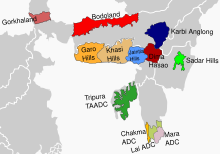
GovernmentThe northeastern states, having 3.8% of India's total population, are allotted 25 out of a total of 543 seats in the Lok Sabha. This is 4.6% of the total number of seats.[citation needed]
20th century separatist unrestIn 1947 Indian independence and partition resulted in the North East becoming a landlocked region. This exacerbated the isolation that has been recognised, but not studied. East Pakistan controlled access to the Indian Ocean.[115] The mountainous terrain has hampered the construction of road and railways connections in the region.[citation needed] Several militant groups have formed an alliance to fight against the governments of India, Bhutan, and Myanmar, and now use the term "Western Southeast Asia" (WESEA) to refer to the region.[116] The separatist groups include the Kangleipak Communist Party (KCP), Kanglei Yawol Kanna Lup (KYKL), People's Revolutionary Party of Kangleipak (PREPAK), People's Revolutionary Party of Kangleipak-Pro (PREPAK-Pro), Revolutionary People's Front (RPF) and United National Liberation Front (UNLF) of Manipur, Hynniewtrep National Liberation Council (HNLC) of Meghalaya, Kamatapur Liberation Organization (KLO), which operates in Assam and North Bengal, National Democratic Front of Bodoland and ULFA of Assam, and the National Liberation Front of Tripura (NLFT).[117] EconomyThe Ministry of Development of North Eastern Region (MDoNER) is the deciding body under Government of India for socio-economic development in the region. The North Eastern Council under MDoNER serves as the regional governing body for Northeast India. The North Eastern Development Finance Corporation Ltd. (NEDFi) is a public limited company providing assistance to micro, small, medium and large enterprises within the northeastern region (NER). Other organisations under MDoNER include North Eastern Regional Agricultural Marketing Corporation Limited (NERAMAC), Sikkim Mining Corporation Limited (SMC) and North Eastern Handlooms and Handicrafts Development Corporation (NEHHDC). List of NE states by NSDP 2023-24
IndustriesAgricultureThe economy is agrarian. Little land is available for settled agriculture. Along with settled agriculture, jhum (slash-and-burn) cultivation is still practised by a few indigenous groups of people. The inaccessible terrain and internal disturbances have made rapid industrialisation difficult in the region.[citation needed] TourismLiving Root Bridges  Northeast India is also the home of many living root bridges. In Meghalaya, these can be found in the southern Khasi and Jaintia Hills.[118][119][120] They are still widespread in the region, though as a practice they are fading out, with many examples having been destroyed in floods or replaced by more standard structures in recent years.[121] Living root bridges have also been observed in the state of Nagaland, near the Indo-Myanmar border.[122] Newspapers and MagazinesNortheast India has several newspapers in both English and regional languages. The largest circulated English daily in Assam is The Assam Tribune. In Meghalaya, The Shillong Times is the highest circulated newspaper. In Nagaland, Nagaland Post has the highest number of readers. G Plus is the only print and digital English weekly tabloid published from Guwahati. In Manipur, Imphal Free Press is a highly respected newspaper. In Arunachal Pradesh, The Arunachal Times is the highest circulated newspaper in Arunachal Pradesh.[citation needed] TransportationAir 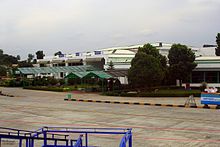 States in the North Eastern Region are well connected by air-transport conducting regular flights to all major cities in the country. The states also own several small airstrips for military and private purposes which may be accessed using Pawan Hans helicopter services. The region currently has two international airports viz. Lokapriya Gopinath Bordoloi International Airport, Bir Tikendrajit International Airport Maharaja Bir Bikram Airport conducting flights to Thailand, Myanmar, Nepal and Bhutan. While the airport in Sikkim is under-construction, Bagdogra Airport (IATA: IXB, ICAO: VEBD) remains the closest domestic airport to the state.
Railway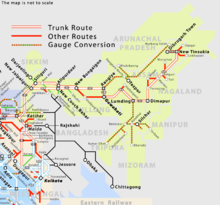 Railway in Northeast India is delineated as Northeast Frontier Railway zone of Indian Railways. The regional network is underdeveloped. States of Manipur, Meghalaya, Mizoram and Sikkim will remain almost disconnected till March 2023 when the capital cities of Manipur, Mizoram and Nagaland are expected to get the rail links once the under construction rail projects are completed.[123] Look East Policy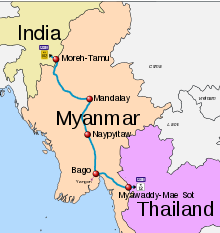  In the 21st century, there has been recognition among policymakers and economists of the region that the main stumbling block for economic development of the Northeastern region is the disadvantageous geographical location.[124] It was argued that globalisation propagates deterritorialisation and a borderless world which is often associated with economic integration. With 98 per cent of its borders with China, Myanmar, Bhutan, Bangladesh and Nepal, Northeast India appears to have a better scope for development in the era of globalisation.[125] As a result, a new policy developed among intellectuals and politicians that one direction the Northeastern region must be looking to as a new way of development lies with political integration with the rest of India and economic integration with the rest of Asia and Oceania, with North, East and Southeast Asia, Micronesia and Polynesia in particular, as the policy of economic integration with the rest of India did not yield much dividends. With the development of this new policy, the Government of India directed its Look East policy towards developing the Northeastern region. This policy is reflected in the Year End Review 2004 of the Ministry of External Affairs, which stated that: "India’s Look East Policy has now been given a new dimension by the UPA Government. India is now looking towards a partnership with the Association of Southeast Asian Nations ASEAN countries, both within BIMSTEC and the India-ASEAN Summit dialogue as integrally linked to economic and security interests, particularly for India’s East and North East region."[126] Development and connectivity projectsThe north-east (NE) region of India lags behind the rest of the country in several development indicators. Although infrastructure has developed over the years, the region has to go a long way to level up the national standard. The total road network of about 377 thousand km of NE contributes about 9.94 per cent of the total roads in the country. Road density in terms of road length per thousand square kilometres. area is very poor in hilly state of Arunachal Pradesh, Mizoram, Meghalaya and Sikkim, while it is significantly high in Tripura and Assam. The road length per 100 km2 area in NE districts varies from as less as below 10 km (in Arunachal Pradesh) to more than 200 km (in Tripura). Other means of transport such as rail, air and water is insignificant in NE (except Assam); however, a few cities of these states having direct air connectivity in the region. The total railway network in the NE is 2,602 km (as on 2011), which is only about 4 per cent of the total rail network of the country. Constructions of roads build the road map for development and road is the only means of mass transport for the entire NE of India. Due to hilly terrain and varied altitudes, rail transport is mainly confined to Assam and water transport is almost non-existent. India's road network has benefited greatly from the articulation of the National Highways Development Project (NHDP). The Ministry has formulated the Special Accelerated Road Development Programme for North East (SARDP-NE) for the development/improvement of more than 10,000 km roads in the NE states. The Ministry of Road Transport and Highways (MoRTH) has been paying special attention to the development of national highways in the region and has assigned 10 per cent of the total allocation of fund for the NE region. Another major constraint of surface infrastructure projects in the NE states has to be linked up with parallel developments in the neighbouring countries, particularly with Bangladesh. The restoration and extension of pre-partition land and river transit routes through Bangladesh is vital for transport infrastructure in NE states. Other international cooperation, such as, revival of Ledo road (Stilwell road) connecting Ledo in Assam to northern Myanmar and extended up to Kunming in south-eastern China, Kaladan Multimodal Transit Project and Trans-Asian Railways, could open up an eastern window for the land-locked NE states of India. Various regional initiatives, such as, the Bangladesh–China–India–Myanmar (BCIM) and Bay of Bengal Initiative for Multi-Sectoral Technical and Economic Cooperation (BIMSTEC), India–Myanmar–Thailand Trilateral Highway (IMTTH) project to link the markets of South and Southeast Asia, are in very initial stages.[127]
See also
ReferencesCitations
Sources cited
External linksWikimedia Commons has media related to Northeast India.
|
||||||||||||||||||||||||||||||||||||||||||||||||||||||||||||||||||||||||||||||||||||||||||||||||||||||||||||||||||||||||||||||||||||||||||||||||||||||||||||||||||||||||||||||||||||||||||||||||||||||||||||||||||||||||||||||||||||||||||||||||||||||||||||||||||||||||||||||||||||||||||||||||||||||||||||||||||||||||||||||||||||||||||||||||||||||||||||||||||||||||||||||||||||||||||||||||||||||||||||||||||||||||||||||||||||||||||||||||||||||||||||||||||||||||||||||||||||||||||||||||||||||||||||||||||||||||||||||||||||||||||||||||||||||||||||||||||||||||||||||||||||||||||||||||||||||||||||||||||||||||||||||||||||||||||||||||||||||||||||||||||||||||||||||||||||||||||||||||||||||||||||||||||||||||||||||||||||||||||||||||||||||||||||||||||||||||||||||||||||||||||||||||||||||||||||||||||||||||||||||










